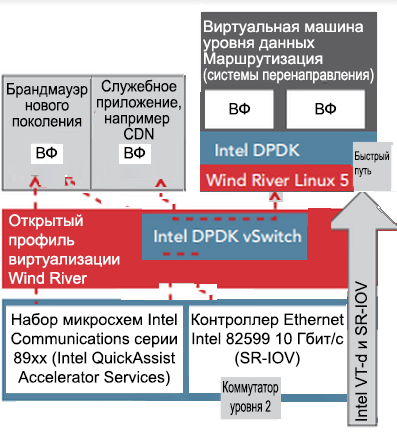SDN, NFV, DPDK, ONP, OPNFV and so on
 Software-managed networks (SDN) and network function virtualization (NFV) are gradually emerging from development laboratories and taking their place in the work environment: they are cheaper, faster, and more flexible alternatives to traditional network equipment.
Software-managed networks (SDN) and network function virtualization (NFV) are gradually emerging from development laboratories and taking their place in the work environment: they are cheaper, faster, and more flexible alternatives to traditional network equipment.At one time, virtualization transformed the deployment capabilities of the OS and applications. Similarly, NFV level 4 and higher (control level) and SDN levels 2 and 3 (packet motion control) transform the ability to manage network traffic using existing equipment and operating systems, both proprietary and open source. In this area, the OPNFV platform, including the Intel Open Network Platform (ONP) Server (reference architecture), will help you quickly begin to design and test your network. Use the instructions for initial setup using standard existing server platforms with Intel Atom to Intel Xeon processors.
Network management and virtualization infrastructure controls define an information model, a set of APIs, and management protocols, such as OpenFlow (a data exchange protocol between the management level and the redirection level) developed for the OpenStack OS.
OpenStack (Juno-Mitaka) provides a platform for creating and managing virtual machines (VMs). Virtual machines are the basic operating systems for all virtual functions. Each virtual machine can have several virtual network interfaces.
')
OpenStack Neutron is a network component for abstracting Linux network configurations using a common API that acts as a wrapper for network functions (Open vSwitch, VLANs, iptables / netfilter, etc.).
OpenDaylight (Helium, Lithium, Beryllium) provides code and architecture for the virtualization of network controllers (level of configuration, monitoring and control)
Open vSwitch (OVS) 2.5.0 is a multi-level virtual network switch of the working layer. (OVS can be a node connected to an OpenDaylight controller)
The Data Plane Development Kit (DPDK) v16.04 is a set of data-level libraries and network adapter drivers that make up a programming platform for quickly processing network packets on general-purpose processors.
Note. Mitaka contains OVS 2.5 with acceleration due to DPDK 2.2
The Intel Open Network Platform (ONP) Server is a reference platform with scripts and other resources to quickly set up a test network. This platform is based on the OPNFV solution, which is a reference hardware-software complex for the development of NFV.
Intel technologies to improve performance

Intel (including Wind River) is making a significant contribution to the development of DPDK and Linux. Recently, Intel developers have joined Intel DPDK vSwitch with the main branch of Open vSwitch, so Neutron can use Intel's accelerated packet processing algorithms, avoiding proprietary plug-ins. The switching logic is based on the Intel DPDK library, due to which packet processing performance is significantly improved. In this case, the switching functions can be integrated both into the main computing network node of OpenStack, and into guest nodes.
The Intel DPDK also contains Layer 3, Load Balancing, and Timers examples; All these examples help speed development. Access to resources is provided as a set of virtual functions: resources are available for many virtual machines and allow you to speed up the exchange of data between virtual machines.
In addition, Intel is developing prototypes of Open NFV (OPNFV) solutions on the OpenDaylight platform in order to tap into opportunities for improving network performance.
Acceleration technology Intel QuickAssist provides the ability to accelerate various algorithms (encryption, compression, unloading) with support for up to 14 separate virtual environments. Intel QuickAssist technology is supported by Intel EP80579 processors (integrated processor), Intel Xeon E5-2600 and E5-2400 series, Intel Core, Intel Pentium, and Intel Celeron with Intel 89xx series chipsets.
Intel also provides the Intel Open Network Platform Server . The Intel ONP Server Reference Architecture includes hardware optimized for a complete set of the latest open source software as a proven template for rapid development. The reference architecture includes specifications, test reports, optimization scripts, and support for Intel Ethernet network interfaces from 1 to 40 Gbps (FTXL710-AM2 4x10GbE).
What SDN / NFV applications are available?
A list of solution partners is available here .
Where to find additional information?
Intel supports several sites, including the following.
- 01.Org/packet-processing : Access to open source projects under the leadership of Intel, including the package processing project.
- NetworkBuilders.Intel.com : a library of information documents, an ecosystem of partners and other sections.
- Information and support is available on the Intel online forum .
- SDN / NFV / DPDK and other network information: Intel Developer Zone .
- Wired Ethernet community on Intel website .
- OPNFV: An Open Platform To Accelerate NFV .
- High Performance, Open Standard Virtualization With NFV and SDN .
- For more information about DPDK, see dpdk.org .
- Examples of use with optimization of small network packets.
- Using Open vSwitch with DPDK on Ubuntu .
- Using Open vSwitch with DPDK for Inter-VM NFV Applications .
- Setting and using speed limit for Open vSwitch with DPDK .
- QoS Configuration and usage for Open vSwitch * with DPDK .
- Implementing an OpenStack Security Group Firewall Driver Using OVS Learn Actions .
Source: https://habr.com/ru/post/310602/
All Articles